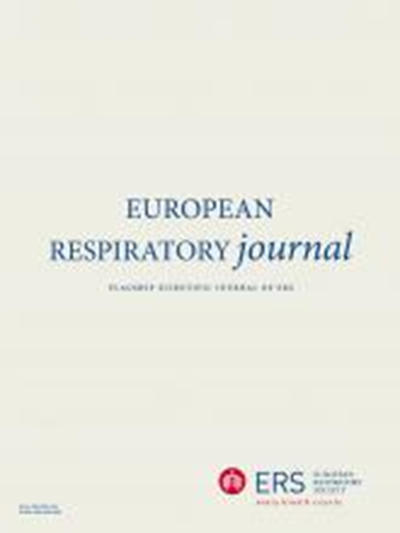联合补充氧气和下颌推进装置治疗阻塞性睡眠呼吸暂停:一项随机对照试验。
IF 21
1区 医学
Q1 RESPIRATORY SYSTEM
引用次数: 0
摘要
梗阻性睡眠呼吸暂停(OSA)的治疗受到持续气道正压不耐受的限制。虽然OSA表现为咽部塌陷性增加和通气控制不稳定,但缺乏针对这两种成分的随机试验。我们测试了将通气控制干预(补充氧气)与上呼吸道机械干预(下颌推进装置,MAD)相结合是否能提高治疗效果。方法在一项多中心随机交叉试验中,41例中重度OSA(呼吸暂停-低通气指数[AHI] bbbb20事件/小时,评分无去饱和标准)患者接受多导睡眠图检查,并采用4种单夜干预措施:供氧(4l·min-1)、MAD、联合治疗和假手术(空气)。初步分析比较了联合治疗和MAD单药治疗的AHI基线变化百分比。次要结果包括唤醒指数和睡眠质量视觉模拟量表(VASSQ)。金标准基线病理生理特征有助于机制亚组分析。结果41例随机患者(14F: 27m, AHIbaseline=49[29,62]事件/小时;中位数[四分位数间距])中,38例完成了所有干预措施。与假手术相比,给氧降低了AHI(估计[CI]: -33[-46, -17]%)、MAD(-54[-64, -41]%)和联合(-68[-77,-57]%);联合治疗比MAD单药治疗降低幅度更大(-14[-23,-4]%,p=0.009)。每3%的去饱和/觉醒标准,联合用药也能改善AHI(与假手术相比-73[-81,-62]%,与MAD相比-17[-25,-7]%)。联合治疗改善了觉醒指数(与假手术相比-36[-43,-27]%)和VASSQ(与假手术相比+0.98[0.39,1.58]),尽管与单独使用MAD相比没有显著性差异。环路增益和可折叠性越高,效果越好。结论:通气控制干预(补充氧气)与上气道干预(MAD)相结合,是一种比单独干预更有希望显著减轻OSA严重程度的方法。本文章由计算机程序翻译,如有差异,请以英文原文为准。
Combined Supplemental Oxygen and Mandibular Advancement Device Therapy for Obstructive Sleep Apnea: A Randomized-Controlled Trial.
INTRODUCTION
Treatment for obstructive sleep apnoea (OSA) is limited by intolerance to continuous positive airway pressure. While OSA manifests due to both increased pharyngeal collapsibility and ventilatory control instability, randomized trials targeting both components are lacking. We tested whether combining a ventilatory control intervention (supplemental oxygen) with an upper airway mechanical intervention (mandibular advancement devices, MAD) improves treatment efficacy.
METHODS
In a multicentre randomized crossover trial, 41 patients with moderate-to-severe OSA (apnoea-hypopnoea index [AHI] >20 events/hr, scored without desaturation criteria) underwent polysomnography with four single-night interventions: oxygen (4 L·min-1), MAD, combination therapy, and sham (air). Primary analysis compared percent change in AHI from baseline between combination therapy and MAD monotherapy. Secondary outcomes included arousal index and visual analog scale for sleep quality (VASSQ). Gold-standard baseline pathophysiological traits facilitated mechanistic subgroup analysis.
RESULTS
Of 41 randomized patients (14F:27 M, AHIbaseline=49 [29, 62] events/hr; median [interquartile range]), 38 completed all interventions. Compared to sham, AHI was lowered with oxygen (estimate[CI]: -33[-46, -17]%), MAD (-54[-64, -41]%), and the combination (-68[-77, -57]%); the combination provided a greater reduction than MAD monotherapy (-14[-23, -4]%, p=0.009). The combination also improved AHI per 3% desaturation/arousal criteria (-73[-81, -62]% versus sham, -17[-25, -7]% versus MAD). The combination improved arousal index (-36[-43, -27]% versus sham) and VASSQ (+0.98[0.39, 1.58] versus sham), albeit not significantly beyond MAD alone. Effects were greatest in those with higher loop gain and collapsibility.
CONCLUSION
Combining a ventilatory control intervention (supplemental oxygen) with an upper airway intervention (MAD) is a promising approach to markedly attenuate OSA severity beyond that offered by each intervention alone.
求助全文
通过发布文献求助,成功后即可免费获取论文全文。
去求助
来源期刊

European Respiratory Journal
医学-呼吸系统
CiteScore
27.50
自引率
3.30%
发文量
345
审稿时长
2-4 weeks
期刊介绍:
The European Respiratory Journal (ERJ) is the flagship journal of the European Respiratory Society. It has a current impact factor of 24.9. The journal covers various aspects of adult and paediatric respiratory medicine, including cell biology, epidemiology, immunology, oncology, pathophysiology, imaging, occupational medicine, intensive care, sleep medicine, and thoracic surgery. In addition to original research material, the ERJ publishes editorial commentaries, reviews, short research letters, and correspondence to the editor. The articles are published continuously and collected into 12 monthly issues in two volumes per year.
 求助内容:
求助内容: 应助结果提醒方式:
应助结果提醒方式:


